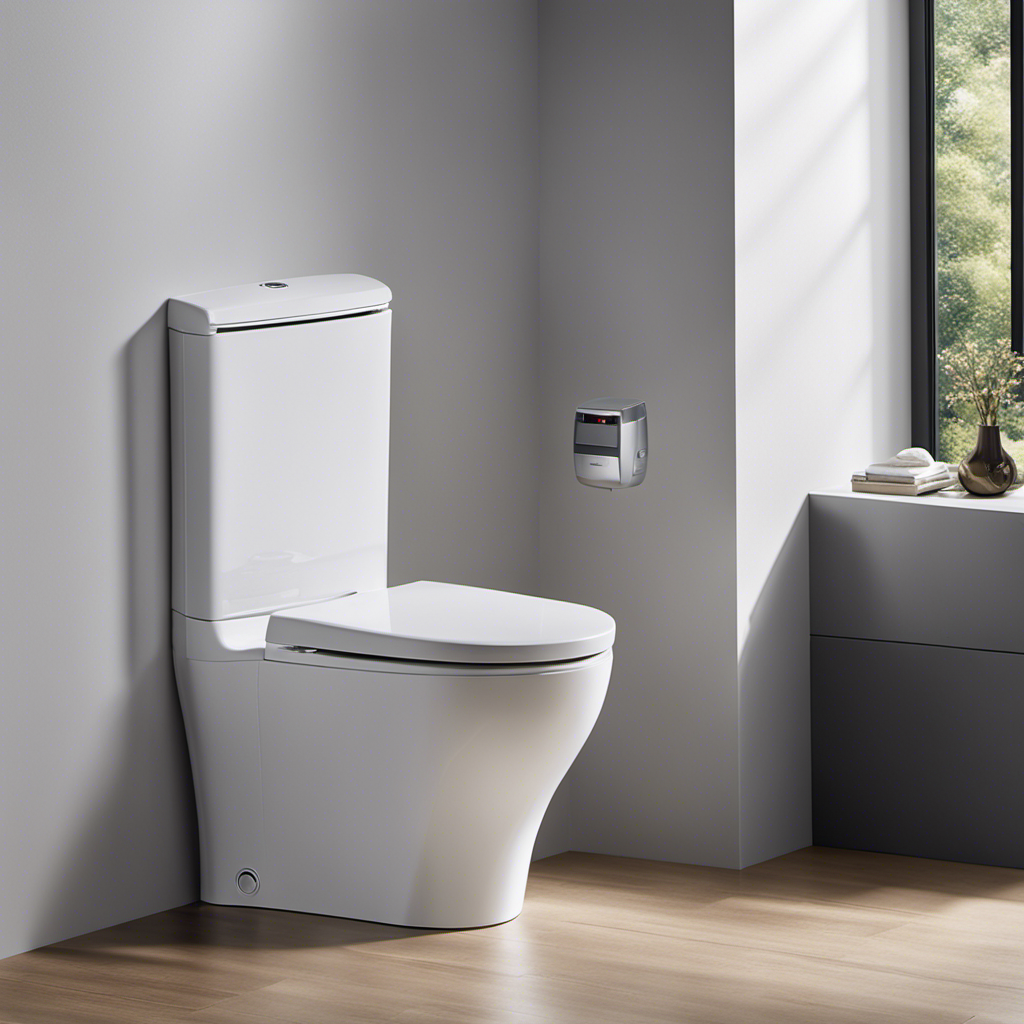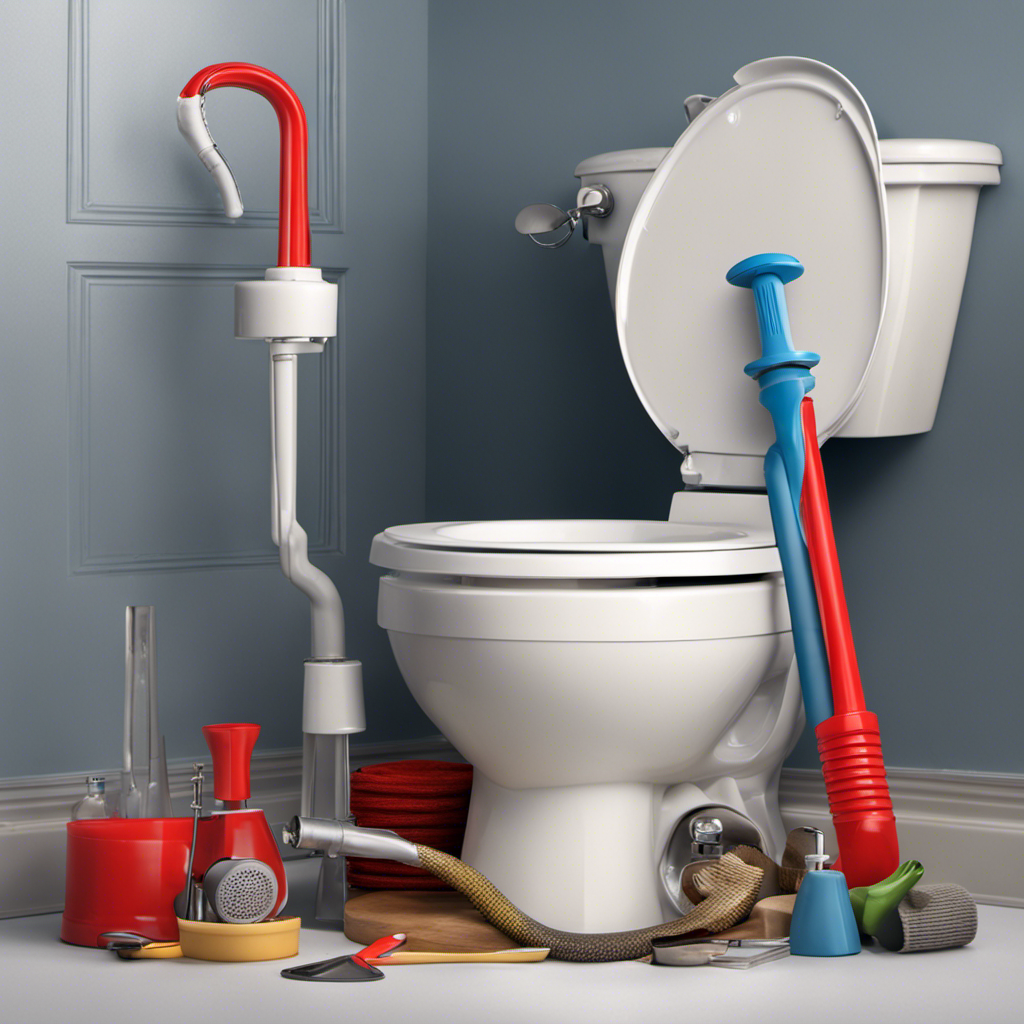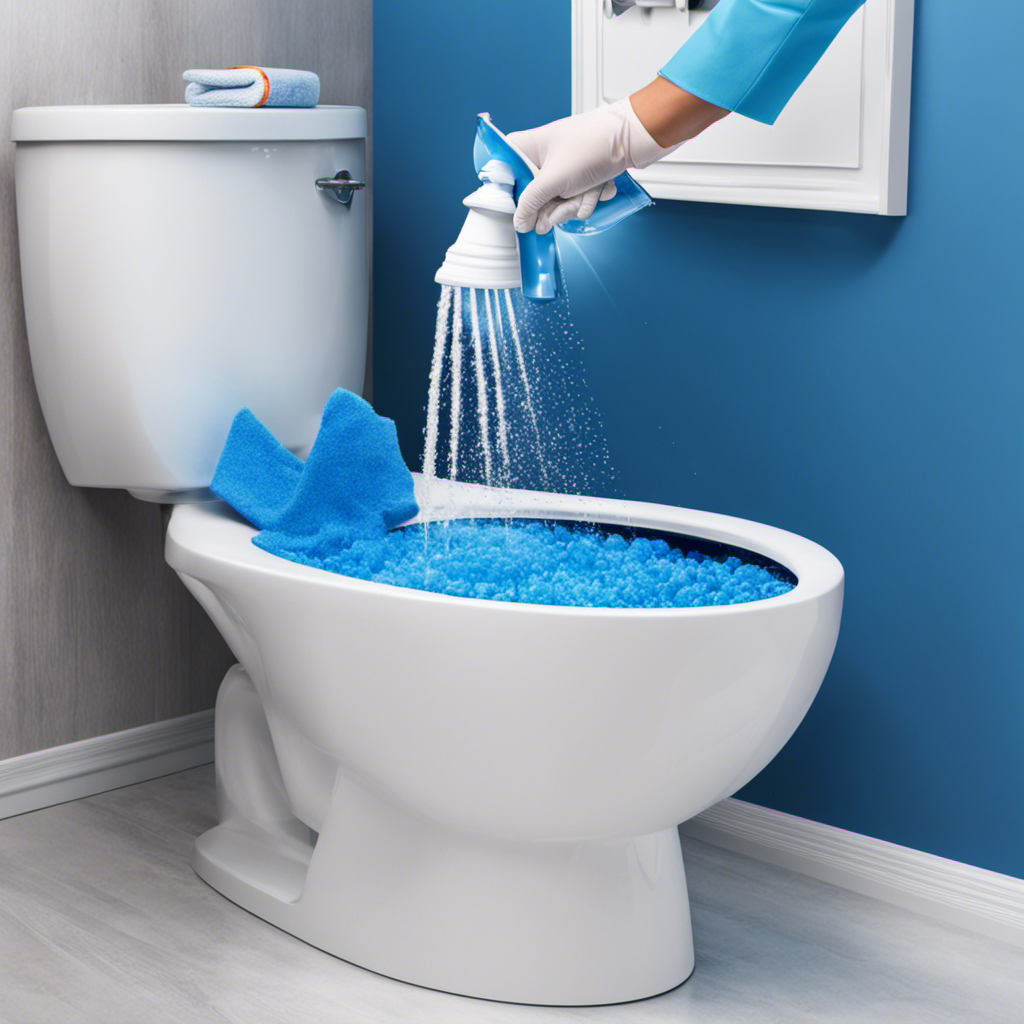I’ve been there before – you’re peacefully sitting on the couch, enjoying a quiet evening, when suddenly you hear it. The annoying sound of a toilet that just won’t stop running.
It’s not just a nuisance; it’s a waste of water and money. But fear not, because I’m here to share with you my expert knowledge on how to make a toilet stop running.
From understanding the causes to troubleshooting persistent issues, I’ve got you covered. Let’s put an end to that endless running and restore peace to your bathroom.
Key Takeaways
- Faulty flapper or fill valve can cause a running toilet.
- Regularly inspect and clean valves to prevent leaks and water wastage.
- Adjust valves and chain length to ensure a proper seal and water level.
- Replacing the flapper or fill valve can fix leaks and continuous running.
Understanding the Causes of a Running Toilet
Toilets can start running for a variety of reasons. One of the most common causes is a faulty flapper valve. This valve is responsible for sealing the tank and preventing water from continuously flowing into the bowl. If it becomes worn out or misaligned, water can leak through, causing the toilet to run constantly.
Another possible culprit is a faulty fill valve. This valve controls the water level in the tank and can malfunction, leading to continuous water flow.
To troubleshoot these issues, start by checking the flapper valve for any signs of wear or misalignment. If necessary, adjust or replace it.
Next, inspect the fill valve for any leaks or malfunctions.
Checking for Common Issues
When it comes to checking for common issues with a running toilet, there are a few key points to keep in mind.
First, I’ll share some valve adjustment tips that can help you fine-tune the water flow and stop the constant running.
Next, I’ll provide a handy flapper replacement guide, outlining the steps to replace this crucial component that often causes leaks.
Valve Adjustment Tips
One of the most important valve adjustment tips is to ensure the water flow is completely shut off before making any adjustments. This step is crucial to avoid any potential water damage or accidents.
Here are some additional valve maintenance tips to keep in mind:
- Regularly inspect the valve for any signs of wear or damage.
- Troubleshoot leaks by checking for loose connections or worn-out washers.
- Clean the valve and surrounding area to prevent debris from interfering with its functionality.
Valve maintenance is essential to keep your toilet running smoothly and prevent any unnecessary water wastage. By following these tips, you can identify and address any issues with the valve promptly, ensuring the proper functioning of your toilet.
Flapper Replacement Guide
Replacing the flapper is a simple and cost-effective solution to fix a toilet that won’t stop running. The flapper is a rubber valve that controls the flow of water from the tank to the bowl. Over time, the flapper can wear out or become misaligned, leading to leaks and continuous running. To troubleshoot water leaks, it’s important to regularly check the flapper for any signs of damage or deterioration. Here is a table outlining some common flapper maintenance tips:
| Flapper Maintenance Tips |
|---|
| Inspect for cracks or tears |
| Clean any debris or mineral buildup |
| Adjust the chain length for proper seal |
Water Level Troubleshooting
To troubleshoot the water level in your toilet tank, start by checking the float valve for any signs of damage or misalignment. This is a common cause of water level problems in toilets.
Here are some steps you can take to troubleshoot and adjust the water level:
-
Inspect the float valve: Look for any cracks or breaks in the valve. Ensure that it is properly aligned and not stuck in the open or closed position.
-
Adjust the water level: If the water level is too high, you can lower it by adjusting the float or bend the float arm downward slightly. If the water level is too low, adjust the float arm upward.
-
Troubleshoot leaks: If you notice any leaks around the fill valve or flapper, replace them to prevent water loss.
Adjusting the Water Level in the Tank
When it comes to adjusting the water level in a toilet tank, there are a few key points to consider.
First, it’s important to find the optimal water level, which usually falls about an inch below the top of the overflow tube. This prevents water from overflowing and causing potential damage.
If you’re experiencing water overflow, there are steps you can take to fix the issue, such as adjusting the float valve or replacing it if necessary.
Optimal Water Level
The optimal water level in a toilet tank should be about one inch below the overflow tube. This ensures proper functionality and prevents any potential water waste or overflow issues. Maintaining the correct water level is important for both water conservation and toilet maintenance.
Here are some reasons why the optimal water level is crucial:
-
Prevents water waste: Having the water level too high can lead to unnecessary water usage, resulting in higher water bills and a negative impact on the environment.
-
Avoids overflow: If the water level is too high, it can overflow through the overflow tube, causing leaks and potential water damage.
-
Ensures proper flushing: A balanced water level is necessary for a strong and efficient flush, preventing any clogs or incomplete flushes.
Fixing Water Overflow
You can easily fix water overflow in your toilet by adjusting the water level to the optimal one inch below the overflow tube. To do this, follow these simple steps:
- Remove the lid of the toilet tank and locate the water level adjustment screw or valve.
- Turn the screw or valve clockwise to decrease the water level or counterclockwise to increase it.
- Flush the toilet and observe if the water level is now below the overflow tube. Adjust as needed.
By adjusting the water level, you can prevent water from continuously running into the overflow tube, saving you money on water bills.
It is also important to regularly check for leaks in your toilet, as they can waste a significant amount of water. To detect leaks, add a few drops of food coloring into the toilet tank. If the color appears in the bowl without flushing, you have a leak that needs to be addressed.
Regular maintenance and water pressure adjustments can help keep your toilet running efficiently.
Adjusting Float Valve
By adjusting the float valve, you can control the water level in the toilet tank. The float valve is responsible for regulating the flow of water into the tank after each flush. If the water level is too high, it can result in continuous running and water wastage.
To maintain the float valve, follow these steps:
- Regularly inspect the float valve for any signs of damage or wear.
- Clean the float valve and surrounding area to remove any debris or buildup that may affect its functionality.
- Adjust the float valve by bending the metal arm or adjusting the screw to achieve the desired water level.
However, if the float valve is beyond repair, it may be necessary to replace it. To replace the float valve:
- Turn off the water supply to the toilet.
- Disconnect the water supply line from the float valve.
- Remove the old float valve and install the new one, following the manufacturer’s instructions.
Remember to always consult a professional if you are unsure or uncomfortable performing these tasks yourself.
Fixing a Faulty Flapper
To fix a faulty flapper, check if it’s properly aligned and adjust it if necessary. A faulty flapper can cause your toilet to continuously run, wasting water and increasing your water bill.
First, open the tank lid and observe the flapper. Make sure it is centered over the drain hole and sits flat on the bottom of the tank. If it is misaligned, gently adjust it to the correct position.
Next, check the chain length. The chain should have enough slack to allow the flapper to fully close but not so much that it gets tangled or caught under the flapper. Adjust the chain length by either lengthening or shortening it using the chain hook or clip.
Once the flapper is properly aligned and the chain length is adjusted, flush the toilet and check for any leaks. Troubleshooting leaks and ensuring proper alignment and chain length can help fix a faulty flapper and stop your toilet from running.
Replacing the Fill Valve
Now that we’ve covered how to fix a faulty flapper, let’s move on to another common cause of a running toilet: a faulty fill valve.
The fill valve is responsible for refilling the tank after each flush. If it’s not working properly, it can lead to water continuously running into the toilet bowl, causing a waste of water and potentially higher water bills.
Here are some steps to help you troubleshoot and repair a fill valve:
- Check for leaks around the fill valve by inspecting the base and the connection to the water supply line.
- If you notice any leaks, tighten the connections or replace the fill valve if necessary.
- Adjust the water level by turning the adjustment screw on the fill valve. This can help prevent water from overflowing into the overflow tube.
Cleaning or Replacing the Flush Valve
If you notice any leaks around the flush valve, you can tighten the connections or replace it if necessary.
Flush valve maintenance is important to ensure your toilet functions properly and doesn’t waste water.
To troubleshoot leaks, start by turning off the water supply to the toilet and flushing to empty the tank.
Then, remove the toilet tank lid and locate the flush valve at the bottom.
Inspect the connections for any signs of leaks or loose fittings.
If you find any, use a wrench to tighten them.
If the leaks persist, it may be necessary to replace the flush valve.
To do this, turn off the water supply, disconnect the water supply line, and unscrew the flush valve from the bottom of the tank.
Install the new flush valve following the manufacturer’s instructions and reassemble the tank.
Troubleshooting Persistent Running Issues
One way you can troubleshoot persistent running issues is by checking the flapper valve for any signs of wear or damage. The flapper valve is a crucial component in the toilet tank that controls the flow of water during the flushing process. If it is worn out or damaged, it can cause continuous water flow, leading to a running toilet.
To identify faulty components and troubleshoot leaks, follow these steps:
- Inspect the flapper valve for any cracks, tears, or misalignment.
- Check the chain connected to the flapper valve to ensure it is properly attached and not too loose or tight.
- Clean the flapper valve and the surrounding area to remove any debris or mineral buildup that could affect its performance.
Frequently Asked Questions
Can I Fix a Running Toilet Without Replacing Any Parts?
Yes, I can fix a running toilet without replacing any parts. By troubleshooting toilet flushing issues and fixing toilet leaks, I can identify and resolve the problem, ensuring a properly functioning toilet.
How Can I Prevent a Toilet From Running in the First Place?
To prevent a toilet from running, regular toilet maintenance is key. By checking for common toilet problems like leaks or worn-out parts, you can address issues early on and avoid a running toilet altogether.
Is It Normal for a Toilet to Run Occasionally?
Yes, it is normal for a toilet to run occasionally. The causes of a continuously running toilet can vary, but troubleshooting common toilet running issues can help resolve the problem.
Can a Running Toilet Lead to a Higher Water Bill?
Yes, a running toilet can lead to a higher water bill. To detect a running toilet, listen for a constant hissing sound. Common causes include a faulty flapper or a problem with the fill valve.
How Long Does It Usually Take to Fix a Running Toilet?
On average, fixing a running toilet takes about 30 minutes to an hour. The most common causes are a faulty flapper or fill valve. It’s a simple repair that can save water and money.
Conclusion
In conclusion, fixing a running toilet is a simple task that anyone can tackle. By understanding the causes of the issue and checking for common problems, you can easily adjust the water level in the tank or fix a faulty flapper.
If those solutions don’t work, replacing the fill valve or cleaning/replacing the flush valve should do the trick. Remember, troubleshooting persistent running issues may take some time and patience, but with a little know-how, you’ll have your toilet running smoothly again in no time.










